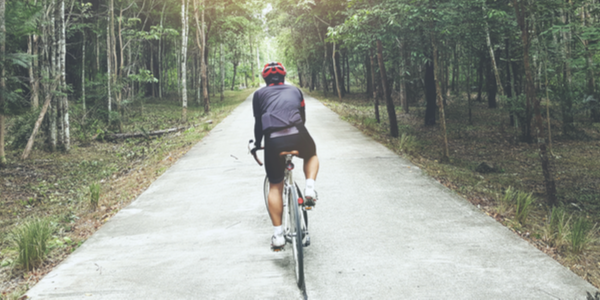
Snacks: Often a small bite to eat between meals. You know, when that afternoon craving sneaks up but dinner isn't planned until a couple more hours…
Of course, we recommend eating a healthy snack when a hunger pang creeps up. But exercise snacks have nothing to do with food snacks and everything to do with physical fitness.
Ahead, we're biting into all things exercise snacking, including what they are, their benefits, and just how to add them effortlessly into your day!
Exercise Snacks: What Are They?
No, exercise snacks aren’t snacks during your workouts but pre- and post-workout nutrition is still important! Sara Dust, bistroMD's Director of Member Success and a team dietitian, tells us that exercise snacks are simply "fun-sized movement sessions [no food involved] that can provide as many health benefits as a full session."
A study published in Exercise and Sport Sciences Reviews1 further defines exercise snacks as "isolated ≤1-min bouts of vigorous exercise performed periodically throughout the day." The researchers further share that the "feasibility and time efficiency of exercise snacks make them suitable for incorporating in between activities of daily living."
Absolutely does exercise snacking sound appetizing, especially when you consider the American Heart Association’s (AHA) recommendation for getting at least 150 minutes of moderate-intensity cardio—also known as aerobic exercise—each week. This begs the question, can such small bursts of movement spread throughout the day actually be beneficial?
Benefits of Exercise Snacking
Regular exercise benefits physical and mental health in various ways—lowering the risk of chronic diseases, enhancing creativity and productivity, and supporting a strong metabolism, just to name a few. Those are fantastic benefits to gain, but let’s dive into what the research says about the specific advantages of exercise snacking.
Glycemic Control
Glycemic control is the ability to manage blood glucose—also known as blood sugar—levels. This is important for all but particularly essential for individuals with insulin resistance and diabetes.
A 2014 study published in Diabetologia2 suggests exercise snacks before meals is a time-efficient and effective approach to improve glycemic control in individuals with insulin resistance.
Cardiorespiratory Health
If you haven’t heard, research hints sitting is the new smoking. Sedentary behaviors and lifestyles are thought to increase the risk of heart disease.
The risks can be offset by aiming for the AHA's recommendation of 150 minutes of aerobic activity each week. While you shouldn’t disregard the importance of regular cardio, exercise snacking may also offset the detrimental effects of prolonged sitting on metabolic outcomes and vascular function according to a recent 2022 study.1
Another study published in Applied Physiology, Nutrition, and Metabolism3 investigated if stair climbing exercise snacks could enhance cardiorespiratory fitness. The researchers randomly assigned one group to perform 3 bouts/day of vigorously climbing a 3-flight stairwell (60 steps), separated by 1-4 hours of recovery, 3 days/week for 6 weeks.
The results? Compared to the non-training group, the climbing "snackers" showed modest, yet significant improvements in their cardiorespiratory fitness.
Weight Management
Increasing physical activity throughout the day can help people manage their weight. This mostly occurs due to a higher non-exercise activity thermogenesis (NEAT)4, which is the energy expended for everything we do that is not sleeping, eating, or sports-related exercise–think walking into work, fidgeting your foot, and washing the dishes.
A 2019 study5 aimed to answer whether or not short bouts of exercise snacks were feasible for improving body composition in adolescents with type 1 diabetes. The researchers found exercise snacks were not only sustainable over a 3-month period, but could also improve body composition in the participants.
Anti-Aging and Longevity
Physical activity is linked to reduced morbidity (disease) and mortality (death) risks. And more researchers and health enthusiasts are starting to emphasize that "all activity counts" across all life domains—regardless of bout duration.
Research published in Nature Medicine6 explored if there was an association between vigorous intermittent lifestyle physical activity (VILPA) embedded into everyday life and morbidity and mortality rates. They also examined if VILPA could be as beneficial as vigorous physical activity (VPA).
After comparing smaller bouts of exercise with non-exercisers, the researchers found participants who completed three, 1-2 minute bouts of VILPA showed a 38%–40% reduction in all-cause and cancer mortality risk and a 48%–49% reduction in cardiovascular (CVD) mortality risk. To add, non-exercisers who engaged in VILPA showed similar effects to VPA exercisers!
The results indicate even small amounts of vigorous non-exercise physical activity are associated with substantially lower mortality. And overall, VILPA may be a suitable physical activity target, especially for people not able or willing to exercise.
Accessibility
One of the top advantages of exercise snacks is they can be completed virtually anywhere —no gym equipment or large space required. Sara also details, "Exercise snacks can be completed in a standing or seated position—really just depends on what works best for you and your environment."
Exercise snacking is also feasible for just about everyone at any age, including in community-dwelling older adults. A pilot study in BMC Geriatrics7 suggests resistance ‘exercise snacking’ may be a feasible home-based strategy for engaging older adults and improving their physical function.
How to Add Exercise Snacks In Your Day
The best part of exercise snacks is you don’t have to commit to long sessions to reap the benefits! Try one (or all!) of these exercise snack ideas to limit sedentary time and add more movement to your day.
Try "Multi-Snacking"
Multitasking doesn’t always run smoothly, especially when one of the tasks requires focus. However, clustering certain tasks time with exercise snacks can be a win-win.
Let’s use heating your bistroMD meals as a "multi-snacking" example: You set the microwave timer for a few minutes, watch the meal heat with anticipation, then ponder if you can let another minute or two go by for it to cool off. Instead of just standing there and watching your meal heat, use that time to multi-snack!
Just think… You could easily get at least 5-10 minutes of exercise snacks solely while your 3 meals per day are heating!
Other ways and times you can multi-snack include:
• Jumping jacks or stretches while your coffee is brewing
• Stationary movements—like alternating arm circles and/or gentle calf stretches—when brushing your teeth (be careful with this and limit exaggerated movements)
• Squats or lunges as you tune into a work meeting (just make sure you’re paying attention and not interrupting!)
• Dancing in the car while parked at a stoplight or in a carwash
• Truly, those minutes will pass while you wait for your morning cup of joe—why not maximize time for your health’s advantage?
Set a "Snackexercise" Timer
New 2023 research8 tells us getting up and moving every 30 minutes—even for as little as 1 minute—can be beneficial for lowering both blood pressure and blood sugar while improving mood and energy.
So especially if you have a desk job and don’t break away from your screen for hours on end, set a "snackexercise" timer for every 30 minutes or so or at least at the top of every hour. ⏱️
A surefire way to ACTUALLY get up is to set a timer on your microwave or smartphone set in another room. Once the timer dings, your really only choice is to get up to turn it off—just don't quiet it out with headphones!
Once you're up, use that time to take another lap, do some jumping jacks, whathaveyou. At the end of your exercise snack, set the time again so you set yourself up for more frequently planned movement.
Full-Day of Exercise Snacking
Still not convinced exercise snacking can total up throughout the day? Let's see how simple you can chew into and rack up daily exercise snacks:
• 6:00 am: 2 minutes of jumping jacks while the coffee brews
• 6:00 am: 3 minutes of alternating lunges as your bistroMD breakfast heats
• 7:00 am: 5-minute dance party in the shower
• 7:15 am: 2 minutes of gentle calf raises when you brush your teeth
• 8:30 am: 1 minute of a planned exercise snack after sitting at your desk
• 10:00 am: 5-minute walk and [actual protein] snack break
• 12:00 pm: 3 minutes of preferred bodyweight movement as your bistroMD lunch heats
• 1:30 pm: 1 minute of a planned exercise snack after sitting at your desk
• 3:00 pm: 5-minute walk and [actual protein] snack break
• 5:00 pm: 3 minutes of alternating squats and push-ups as your bistroMD dinner heats
• 8:00 pm: 2 minutes of alternating when you brush your teeth
Combined, that's over 30 extra minutes of exercise in your day! 🤯 This doesn't even factor in additional steps, fidgeting, etc. you already do throughout the day.
Exercise Snacking: Final Takeaways
Exercise snacks are bite- and fun-sized movements you can add throughout the day. Even if they're short bouts, exercise snacking can help improve glycemic control, manage weight, and provide other impressive benefits.
The bottom line is it's less important how you move, but just that you make a consistent effort to increase activity throughout the day—even if just for a few minutes!







